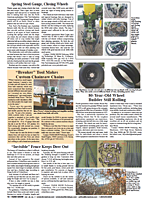You have reached your limit of 3 free stories. A story preview is shown instead.
To view more stories
(If your subscription is current,
click here to Login or Register.)
Heirloom Blonde Cucumber Stands Out
A white heirloom cucumber from Livermore, Maine, has made an impression within one family for generations. Now, it’s making a splash on a larger scale.
Boothby’s Blonde is a strain of white cucumber that seems to bear a close relation to a 1920s variety known as Salad. Both cukes have black spines and turn a vib
..........
You must sign in, subscribe or renew to see the page.

You must sign in, subscribe or renew to see the flip-book
Heirloom Blonde Cucumber Stands Out
A white heirloom cucumber from Livermore, Maine, has made an impression within one family for generations. Now, it’s making a splash on a larger scale.
Boothby’s Blonde is a strain of white cucumber that seems to bear a close relation to a 1920s variety known as Salad. Both cukes have black spines and turn a vibrant orange when overripe. The fruit looks similar to “lemon” cucumbers, though they tend to be longer and broader, and the color leans more yellow than in European white cucumbers.
Boothby’s Blonde tastes best when picked smaller, around 6 to 8 in., making it ideal for eating whole or turning into gourmet pickles. According to the Slow Food Foundation for Diversity, Henry Boothby settled in Maine in 1720, and his family cultivated the cucumber in the generations that followed.
Fans of Boothby’s Blonde say it has a pleasant flavor and crisp texture. That’s partly due to the large seed cavity, which increases sweetness. The yellowish cream color of the fruit stands out against the warty skin and black spines that cover it. Still, they don’t require peeling, making them ideal for snacking straight from the garden. They have a high water content and only become bitter when oversized, making them a versatile ingredient in many dishes.
They’re small but productive, making them an easy choice for growing in small spaces. Expect the Boothby’s Blonde to produce fruit within 55 days, putting it on the early end for cucumbers.
Seeds should be planted in full sun once the soil temperature has warmed. You can also start them indoors up to four weeks before the last frost. They grow best in fertile soil that’s amended with compost. Keep the soil well-watered, and trellis the vines to allow for ample air circulation. Like all cucumbers, it can benefit from growing on black plastic to both suppress weeds and concentrate heat. Avoid harvesting bright yellow fruits and anything over 8 in., as they tend to be bitter.
Though Boothby’s Blonde is increasing in popularity, it’s still at risk of dying out in favor of more market-ready varieties. Purchase seeds from Seed Savers Exchange, Pinetree Garden Seeds, or other heirloom growers to continue their legacy.
To read the rest of this story, download this issue below or click
here to register with your account number.





